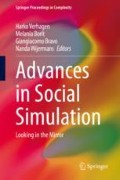Abstract
This work assesses the effectiveness of labour market policies in reducing unemployment during a recession. In order to do so, I build an agent-based model and analyse the impact of typical labour market policies on the short-, medium- and long-term development of unemployment. I analyse the effect of (1) a reduction of unemployment benefits (UB), (2) increasing search efforts among unemployed, (3) a mixture of both aforementioned policy responses, (4) governmental transfers to steer consumption and (5) short-time work. In the following extended abstract, I present the results of two policy experiments, (3) and (5). The methods I use here are slightly different from those in the existing ABM literature. The analyses are carried out as policy experiments. In order to evaluate the effectiveness of a labour market policy, the graphics of this work illustrate range of effects of the specific policy measure on unemployment (mean and confidence intervals across several runs) instead of solely depicting the mean development. In contrast to equilibrium models, I find that measures which raise the pressure on unemployed to find a job, measures (1) to (3), have no noteworthy impact or slightly increase unemployment in the long run. Instead, governmental interventions which stabilise aggregate supply and demand, like (4) and (5), rather dampen unemployment.
Access this chapter
Tax calculation will be finalised at checkout
Purchases are for personal use only
Notes
- 1.
For the model code, please contact the author: tom.bauermann@ruhr-uni-bochum.de. An early version of the full paper can be downloaded from: https://www.boeckler.de/pdf/v_2018_10_26_bauermann.pdf.
- 2.
The average unemployment in the model is at 9.01% and its average standard deviation 2.0%. The government starts its intervention when unemployment exceeds 13.0% or, in other words, when unemployment exceeds mean unemployment by 2*SD.
- 3.
To determine the number of runs (i.e. 700 random seeds), I follow the concept of variance stability [10]. The variance of the variates settles to the mean variance, 700 runs. To ensure that this burn-in phase was passed when the government starts its policy, the policy shift starts at period 1000. The 95% confidence bands follow the standards in the literature [3].
- 4.
The baseline ratio of unemployment benefits to average wage, 50%, is, roughly, the average net replacement rate (NRR) in Germany in the early 2000s, which was taken from the NRR statistics [15]. The magnitude of the reduction was found by following the reduction of UB of long-term unemployed in Germany in the course of the labour market reforms in the 2000s. The reduction of this work is a bit milder compared to the mentioned reduction [4]. Due to the absence of a calibration criteria for search efforts, doubling the search efforts mimics a significant but still realistic increase.
- 5.
The short-time work scheme followed, roughly, the German short-time work in the aftermath of the recent financial crisis [1]. The firms could reduce hours worked and wage bill down to 45%.
References
Brenke, K., Rinne, U., Zimmermann, K.F.: Short-time work: the German answer to the great recession. Int. Labour Rev. 152, 287–305 (2013)
Delli Gatti, D., Desiderio, S., Gaffeo, E., et al.: Macroeconomics from the Bottom-Up. Springer, Milano (2011)
Dosi, G., Napoletano, M., Roventini, A., et al.: Rational heuristics? Expectations and behaviors in evolving economies with heterogeneous interacting agents. LEM Work. Paper Ser. 31, 1–41 (2017)
Engbom, N., Detragiache, E., Raei, F.: The German labor market reforms and post-unemployment earnings. IMF Work. Paper 15(162), 1–26 (2015)
Geroski, P.: What do we know about entry? Int. J. Ind. Organ. 13, 421–440 (1995)
Godley, W., Lavoie, M.: Monetary Economics. An Integrated Approach to Credit, Money, Income, Production and Wealth, 2nd edn. Palgrave Macmillan, Hampshire (2012)
Grazzini, J., Richiardi, M.: The agent-based experiment. In: Delli Gatti, D., Fagiolo, G., Gallegati, M., et al. (eds.) Agent-Based Models in Economics: A Toolkit. Cambridge University Press, Cambridge (2018)
Herzog-Stein, A., Lindner, F., Sturn, S.: The German employment miracle in the Great Recession: the significance and institutional foundations of temporary working-time reductions. Oxf. Econ. Pap. 70, 206–224 (2018)
Howell, D., Rehm, M.: Unemployment compensation and high European unemployment: a reassessment with new benefit indicators. Oxf. Rev. Econ. Policy 25, 60–93 (2009)
Lee, J.S., Filatova, T., Ligmann-Zielinska, A., et al.: The complexities of agent-based modeling output analysis. J. Artif. Soc. Soc. Simul. 18, 1–26 (2015)
Mitman, K., Rabinovich, S.: Unemployment benefit extensions caused jobless recoveries!? PIER Working Paper 14-013:1-33 (2014)
Nystroem, K., Elvung, G.Z.: New firms and labor market entrants: is there a wage penalty for employment in new firms? Small Bus. Econ. 43, 399–410 (2014)
Romer, P.: The Trouble with Macroeconomics. Available via Personal Homepage. https://paulromer.net/wp-content/uploads/2016/09/WP-Trouble.pdf (2016). Cited 02 May 2018
Salle, I., Seppecher, P.: Deleveraging crises and deep recessions: a behavioural approach. Appl. Econ. 47, 3771–3790 (2015)
van Vliet, O., Caminada, K.: Unemployment replacement rates dataset. https://www.universiteitleiden.nl/en/law/institute-for-tax-law-and-economics/economics/data-sets/unemployment-replacement-rates-dataset (2018). Cited 02 May 2018
Author information
Authors and Affiliations
Corresponding author
Editor information
Editors and Affiliations
Rights and permissions
Copyright information
© 2020 Springer Nature Switzerland AG
About this paper
Cite this paper
Bauermann, T. (2020). Times of Crises and Labour Market Reforms. In: Verhagen, H., Borit, M., Bravo, G., Wijermans, N. (eds) Advances in Social Simulation. Springer Proceedings in Complexity. Springer, Cham. https://doi.org/10.1007/978-3-030-34127-5_6
Download citation
DOI: https://doi.org/10.1007/978-3-030-34127-5_6
Published:
Publisher Name: Springer, Cham
Print ISBN: 978-3-030-34126-8
Online ISBN: 978-3-030-34127-5
eBook Packages: Mathematics and StatisticsMathematics and Statistics (R0)

